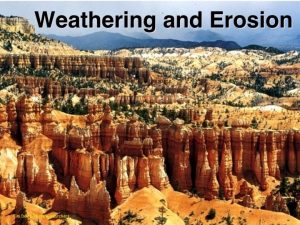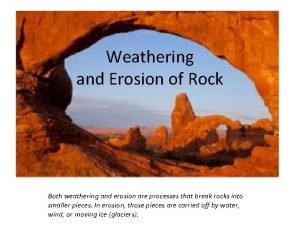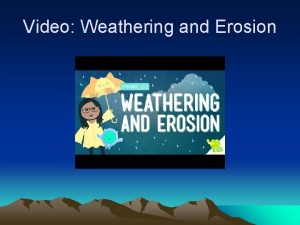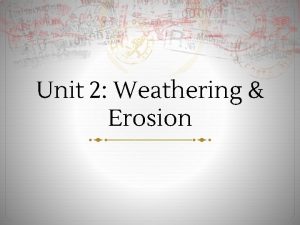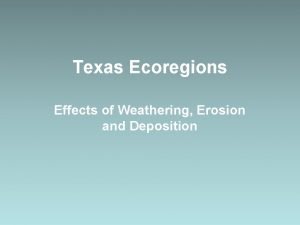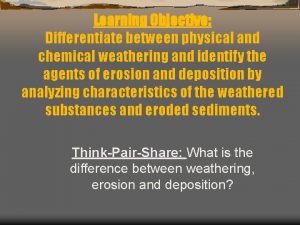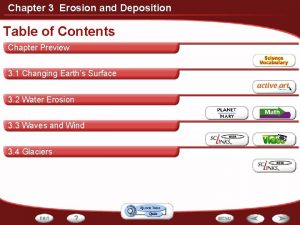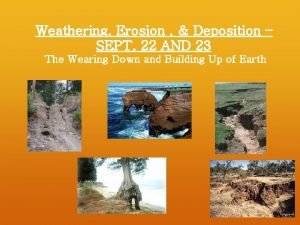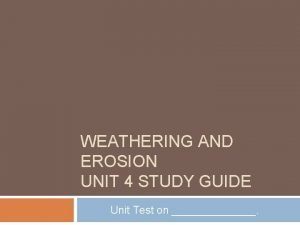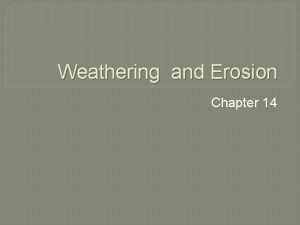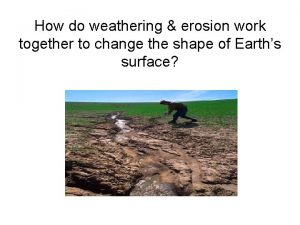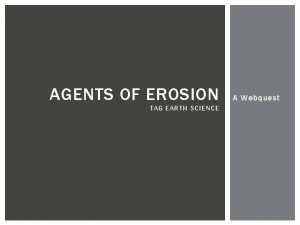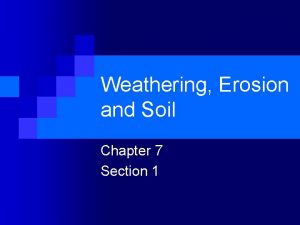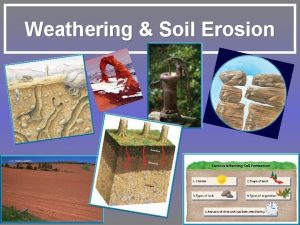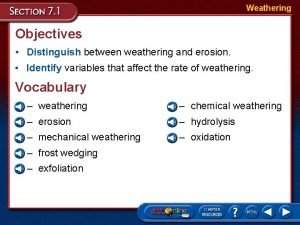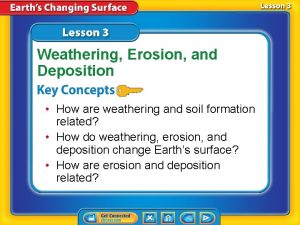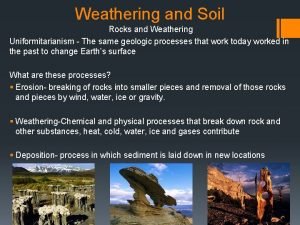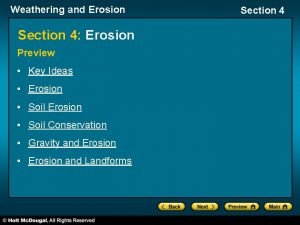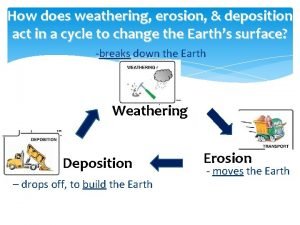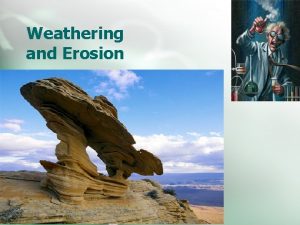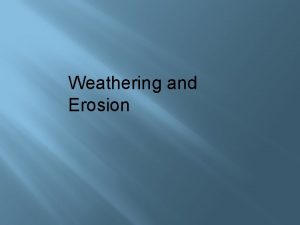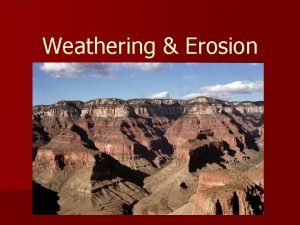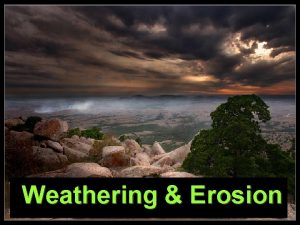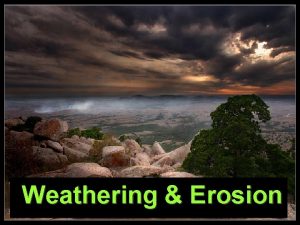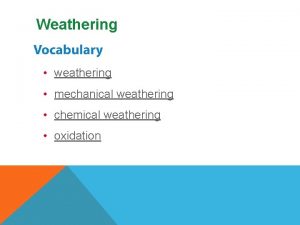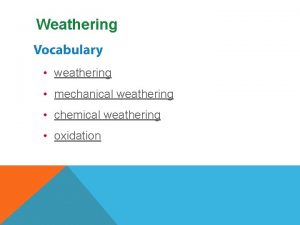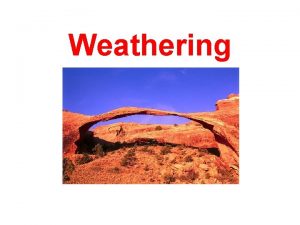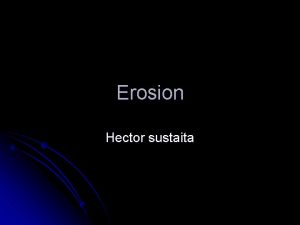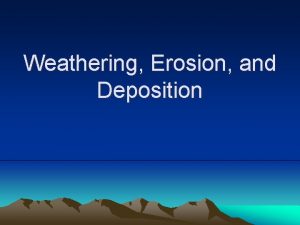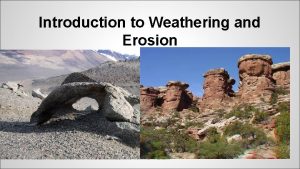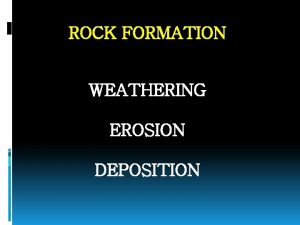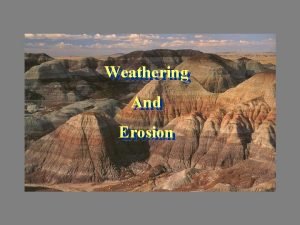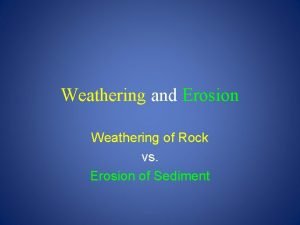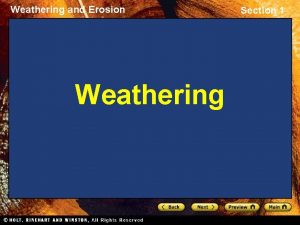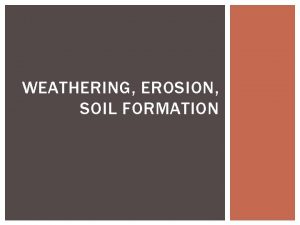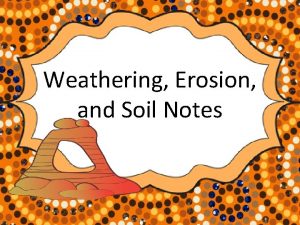Weathering Weathering and Erosion v Weathering is the
























- Slides: 24

Weathering

Weathering and Erosion v Weathering is the chemical or physical breakdown of a rock or mineral due to exposure to the atmosphere. v Erosion is the removal or transport of material by 5 possible agents: running water, glaciers, waves, wind, and gravity. v www. gg - wind, water, waves, gravity, glaciers v Humans and animals may also play a part in erosion.

Types of Weathering v There are two major types of weathering: v 1. Physical (mechanical) – mechanical breakdown of rock or mineral. Just breaks it into smaller pieces, composition of the material is NOT changed!! v 2. Chemical – decomposition of material. The composition IS changed!!

Mechanical Weathering – Video Clip

Physical (Mechanical) Weathering There are several different types of physical weathering: v 1. Frost or Ice Wedging – alternating freezing and thawing of moisture in rock openings causing rock disintegration. v Water expands as it freezes, this breaks the rock into angular fragments. v Occurs A LOT in Western New York – causes most potholes!! v Will ONLY occur in areas where the temperature alternates above freezing and below freezing!!! v

Frost Wedging animation

Physical (Mechanical) Weathering Exfoliation – Erosion of upper rock causes underlying rock to expand resulting in cracking and peeling of rock in slabs. v. Think of onion skin layers and peeling them off!! v 2.

Pictures of Stone Mountain, Georgia – exfoliation here has caused an overall rounded shape to the mountain.

Physical (Mechanical) Weathering v 3. Organic Activity – plant roots or animals like burrowing worms can cause rock to breakdown.

Physical (Mechanical) Weathering v 4. Wetting and Drying - addition of water to mineral structure causes structure to expand.

Physical (Mechanical) Weathering v IMPORTANT!! v Physical weathering increases the surface area of rocks/minerals. v Taking a rock/mineral and breaking it up into smaller pieces causes it to take up more space (surface area) and will eventually increase the rate of chemical weathering to occur.


Chemical Weathering – Video Clip

Chemical Wethering v There also several different types of chemical weathering: v 1. Hydrolosis – chemical reaction between water and other substances. v Silicate minerals will often form clay from this process. Kaolin mine, central Georgia (feldspar weathered into clay by hydrolosis)

Chemical Weathering v 2. Carbonic Acid – dissolving of substances by acids in water often leaving insoluble remains.

Chemical Weathering v 3. Oxidation – chemical reaction of a substance with oxygen causing a rust material to form.

Weathering and Climate v Climate plays a very important role in weathering. v The temperature and amount of moisture influences the type of weathering that will occur. v Warm and wet climates produce mostly chemical weathering. Never any frost wedging. v Cool and slightly wet climates produce mostly physical weathering.

Cleopatra’s Needle in Egypt – warm dry climate – little to no weathering occurs Cleopatra’s Needle was moved to New York and has weathered considerably in only 80 years due to the cold and wet climate.

Weathering and Resistance v The harder the rock or mineral is, the more resistant it will be to weathering. v Any rock with quartz will be quite resistant due to quartz’s hardness. is quartz’s hardness? ? 7 v Rocks made mostly of calcite, a very soft mineral, will be easily weathered. v What is calcite’s hardness? ? v What 3

Porosity and Permeability v Porosity: material The percentage of pore space in a v Permeability: The ability of a material to let liquid (water) pass through it. v Impermeable: When something will not let liquids pass through it (usually water is the liquid).

Does the grain size or the size of the sediment affect the porosity? v. NO!!!!! v Smaller pieces have smaller gaps between them but there are lots of gaps. v Larger pieces have fewer gaps, but they are larger gaps. v So…the amount of pore space (porosity) does not change with grain size.

MIXED grain sizes WILL affect the porosity though because the small pieces fill in the space between the big pieces. Sorted Unsorted


Permeability v If something has Low Porosity, then permeability will be SLOW v If something has High Porosity, then permeability will be FAST
 Chad lentz
Chad lentz Erosion in trans pecos
Erosion in trans pecos What is the difference between weathering and erosion?
What is the difference between weathering and erosion? Waves dropping sand on the beach is an example of what
Waves dropping sand on the beach is an example of what Erosion video bill nye
Erosion video bill nye Hydrolysis
Hydrolysis Weathering and erosion difference youtube video
Weathering and erosion difference youtube video Weathering and erosion questions
Weathering and erosion questions Weathering in post oak savannah
Weathering in post oak savannah Deposition in blackland prairies
Deposition in blackland prairies Weathering and erosion agents
Weathering and erosion agents Difference between weathering and erosion
Difference between weathering and erosion Weathering erosion and deposition
Weathering erosion and deposition Weathering and erosion
Weathering and erosion Weathering and erosion study guide
Weathering and erosion study guide Chapter 14 weathering and erosion review answers
Chapter 14 weathering and erosion review answers Dust bowl 1930s
Dust bowl 1930s Weathering webquest
Weathering webquest Chapter 7 weathering erosion and soil
Chapter 7 weathering erosion and soil Soils in ____ contain little organic material and are thin.
Soils in ____ contain little organic material and are thin. Distinguish between weathering and erosion
Distinguish between weathering and erosion Weathering and soil erosion
Weathering and soil erosion How does temperature break down rocks
How does temperature break down rocks Types of soil erosion
Types of soil erosion Weathering erosion and deposition
Weathering erosion and deposition


